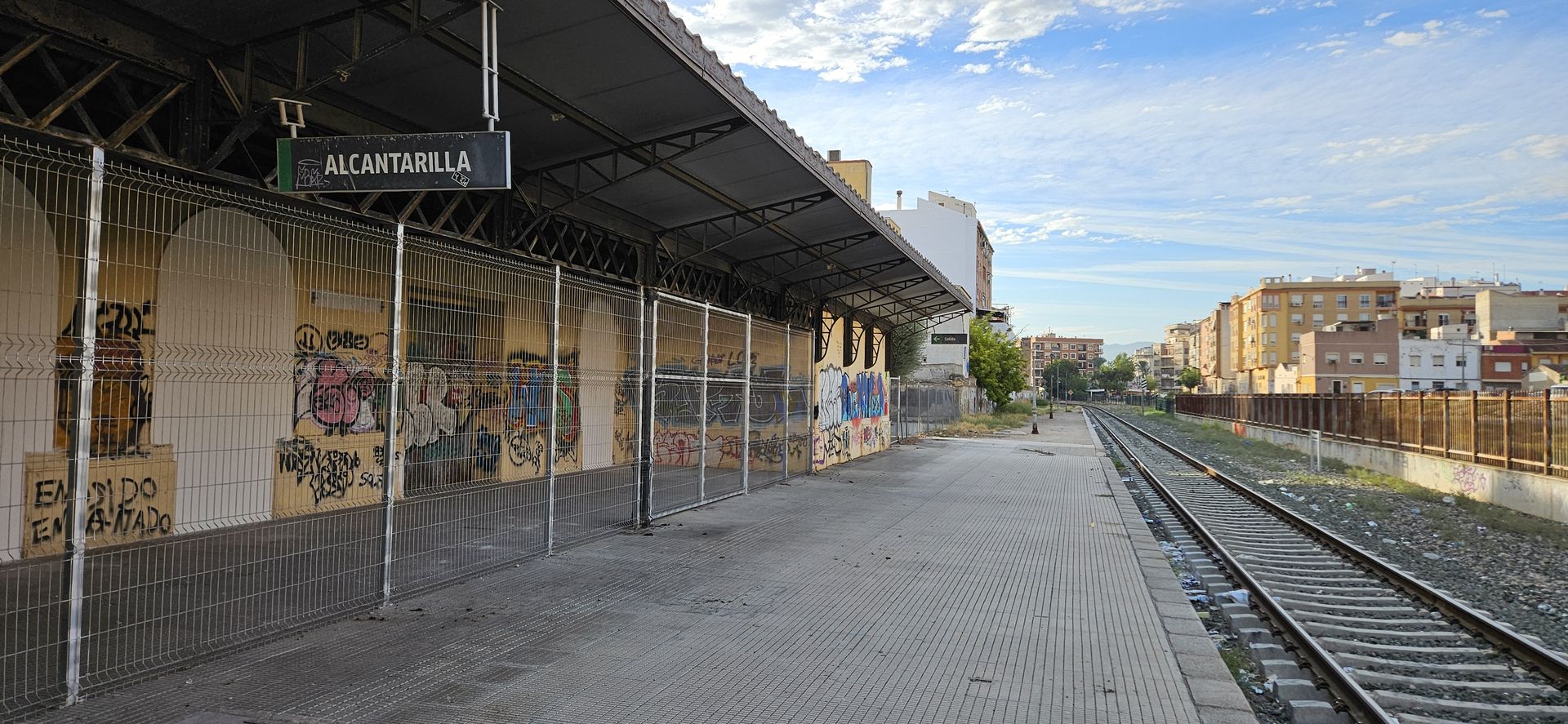Chinchilla de Montearagón – Murcia-Mercancías
CHARACTERISTICS
- Estación de Chinchilla de Montearagón-Aguja (P.K. 298,400) / VM
- Estación de Archena-Fortuna (UTM 30S 654601 4221853); (P.K. 433,000) / VM
- Estación de Murcia-Mercancías (UTM 30S 658549 4203980 ); (P.K. 454,300) / VM
From the end of the 19th century and for most of the 20th, Cartagena developed a prosperous economy based on the exploitation of silver, lead and zinc mineral deposits in the mining region of Cartagena-La Unión. For this reason, and because of its strategic position in the Mediterranean, in 1852 the MZA Company, the railway company from Madrid to Zaragoza and Alicante, began to study alternatives for a railway connection between this region of Murcia and the capital.
[...] in 1852 the MZA Company, the railway company from Madrid to Zaragoza and Alicante, began to study alternatives for a railway connection between this region of Murcia and the capital.
The new route, which would connect in the town of Chinchilla de Montearagón, Albacete, with the existing Madrid-Valencia line, was awarded to the Marquis of Salamanca in 1860, who later ceded the rights to the company MZA. [1] [2]
Three years after the concession had been awarded, some sections were already in service, those with the least topographical complexity, such as the Murcia-Cartagena line, which was not the section covered by this study. And finally, in 1865, the entire line was inaugurated. [3]
Three years after the concession was awarded, some sections were already in service [...] such as the Murcia-Cartagena [...]
This line has been the backbone for other connections between towns in the region, in a process of creating a true regional railway network. Thus, the Murcia-Alicante line connects with the latter at Alquerías-El Reguerón, 9 km from the city of Murcia. The Murcia-Lorca line starts at the Alcantarilla-Campoamor station. And the line from Murcia to Caravaca connects with the Alguazas station. [1]
More recently, ADIF undertook major works to rectify the route in order to correct some very tight bends that forced the train to slow down considerably in the foothills of the Betic System between Hellín and Cieza. [3] The new route has eliminated 11 level crossings and reduced the length of the route by 17 km, which in terms of travelling time means a saving of 15 minutes.
[4]

Cargadero de Chinchilla de Montearagón (Albacete)
It should be noted that, at present, there are no passenger services on the route, with the exception of a single Intercity journey from Madrid to Murcia on Friday afternoons, returning to Madrid on Sunday afternoons.Furthermore, from 2022, the line will be interrupted by the underground works on the Mediterranean corridor in the city of Murcia, requiring a special bus service to complete the journey to the capital from the Archena-Fortuna station. [5] [6]
In terms of the landscape, the line runs through a landscape defined mainly by the interior plains and countryside typical of south-eastern La Mancha and north-western Murcia, with large areas of farmland on relatively flat terrain.This type of landscape is interrupted in the section between Calasparra and Cieza, where the configuration of a more varied valley can be seen, both in terms of orography and land use.
[...] currently, there are no passenger services on the route, with the exception of a single Intercity journey from Madrid to Murcia on Friday afternoons.
This same section between Calasparra and Cieza has been transformed for the most part into a greenway that runs for 10 km between Las Cañadas and Corredera. The building of the La Macetúa halt has been preserved on the section, connected to a viewpoint from which to observe the flowering of the surrounding vegetation, a phenomenon with which the new greenway aims to characterise itself. Just one kilometre from the halt, the route crosses a metal bridge supported by two stone bases embedded in the ground, which is quite significant and very well preserved.
Just one kilometre from the halt, the route crosses a metal bridge supported by two stone bases embedded in the ground, which is quite significant and very well preserved.
In general, the stations are in a ruinous state and completely abandoned. In almost none of them is it possible to consider their architectural rehabilitation. There are, however, some stations that have been reused to house socio-cultural services. In Alcantarilla, the station has changed use and now houses various clubs and associations. In Alguazas, taking advantage of the Camino de la Cruz de Caravaca, the station and depot complex has been successfully restored to create a hostel and a police station, both connected to a semi-covered square. This is a very good example of heritage reuse, achieving a real use for the facilities. Probably part of the success of its functionality lies in the fact that it is in the centre of an active town, just like the Alcantarilla station. The remote location of almost all the other stations, together with their current state, does not seem to make a similar recovery viable.
Category B1.
Non-electrified track with concrete sleepers in a reasonable state of repair.
Photographic report

Vista de la Línea 320 en las inmediaciones de Pozo Cañada (Albacete)

Apartadero de Calasparra (Murcia)

Apartadero - cargadero de Alguazas - Molina (Murcia)

Apeadero de Alcantarilla (Murcia)

Vista de la Línea 320
References
-
J. P. Torner, «Albacete a Cartagena», Ferrocarriles de España, 10-feb-2012. [En línea]. Ver referencia
-
F. Wais, Historia de los ferrocarriles españoles. Editora Nacional, 1974.
-
Federación Castellano Manchega de Amigos del Ferrocarril, «Línea 320 Chinchilla de Montearagón Aguja km 298,4 a Cartagena», Federación Castellano Manchega de Amigos del Ferrocarril, abr-2015. [En línea]. Ver referencia
-
C. Caballero, «La variante de Camarillas ya es una realidad», La Opinión de Murcia, 21-mar-2019. [En línea]. Ver referencia
-
Adif, «Estación de Archena-Fortuna», Información al usuario - Estaciones. [En línea]. Ver referencia
-
Onda Regional de Murcia, La Plataforma por el tren de Hellín reivindica la recuperación de la línea Chinchilla-Cartagena, 2023.